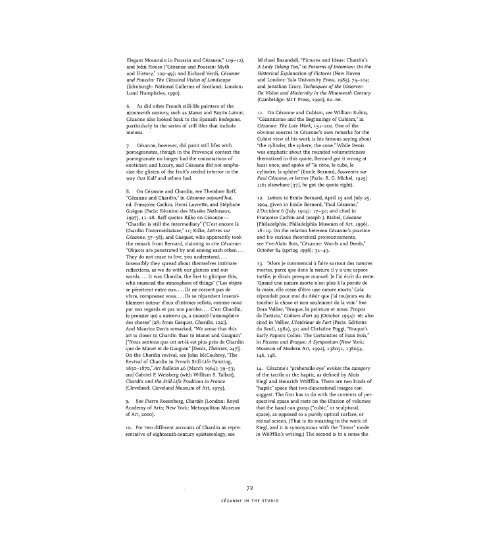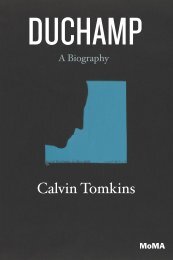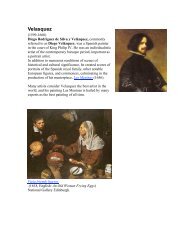Still Life in Watercolors
qbj8dgc
qbj8dgc
- No tags were found...
You also want an ePaper? Increase the reach of your titles
YUMPU automatically turns print PDFs into web optimized ePapers that Google loves.
Elegant Mounta<strong>in</strong> <strong>in</strong> Pouss<strong>in</strong> and Cézanne/' 109-12),<br />
and John House ("Cezanne and Pouss<strong>in</strong>: Myth<br />
and History," 129-49); an d Richard Verdi, Cézanne<br />
and Pouss<strong>in</strong>: The Classical Vision of Landscape<br />
(Ed<strong>in</strong>burgh: National Galleries of Scotland; London:<br />
Lund Humphries, 1990).<br />
6. As did other French still-life pa<strong>in</strong>ters of the<br />
n<strong>in</strong>eteenth century, such as Manet and Fant<strong>in</strong>-Latour,<br />
Cézanne also looked back to the Spanish bodegone,<br />
particularly <strong>in</strong> the series of still lifes that <strong>in</strong>clude<br />
melons.<br />
7. Cézanne, however, did pa<strong>in</strong>t still lifes with<br />
pomegranates, though <strong>in</strong> the Provençal context the<br />
pomegranate no longer had the connotations of<br />
exoticism and luxury, and Cézanne did not emphasize<br />
the glisten of the fruit's seeded <strong>in</strong>terior <strong>in</strong> the<br />
way that Kalf and others had.<br />
8. On Cézanne and Chard<strong>in</strong>, see Theodore Reff,<br />
"Cézanne and Chard<strong>in</strong>," <strong>in</strong> Cézanne aujourd'hui,<br />
éd. Françoise Cach<strong>in</strong>, Henri Loyrette, and Stéphane<br />
Guégan (Paris: Réunion des Musées Nationaux,<br />
1997), 11-28. Reff quotes Rilke on Cézanne—<br />
"Chard<strong>in</strong> is still the <strong>in</strong>termediary" ("C'est encore là<br />
Chard<strong>in</strong> l'<strong>in</strong>termédiaiare," 11; Rilke, Lettres sur<br />
Cézanne, 37-38); and Gasquet, who apparently took<br />
the remark from Bernard, claim<strong>in</strong>g to cite Cézanne:<br />
"Objects are penetrated by and among each other....<br />
They do not cease to live, you understand<br />
Insensibly they spread about themselves <strong>in</strong>timate<br />
reflections, as we do with our glances and our<br />
words It was Chard<strong>in</strong>, the first to glimpse this,<br />
who nuanced the atmosphere of th<strong>in</strong>gs" ("Les objets<br />
se pénètrent entre eux Ils ne cessent pas de<br />
vivre, comprenez vous Ils se répandent <strong>in</strong>sensiblement<br />
autour d'eux d'<strong>in</strong>times reflets, comme nous<br />
par nos regards et par nos paroles C'est Chard<strong>in</strong>,<br />
le premier qui a entrevu ça, a nuancé l'atmosphère<br />
des choses" [28; from Gasquet, Chard<strong>in</strong>, 122]).<br />
And Maurice Denis remarked, "We sense that this<br />
art is closer to Chard<strong>in</strong> than to Manet and Gaugu<strong>in</strong>"<br />
("Nous sentons que cet art-là est plus près de Chard<strong>in</strong><br />
que de Manet et de Gaugu<strong>in</strong>" [Denis, Théories, 247]).<br />
On thé Chard<strong>in</strong> revival, see John McCoubrey, "The<br />
Revival of Chard<strong>in</strong> <strong>in</strong> French <strong>Still</strong>-<strong>Life</strong> Pa<strong>in</strong>t<strong>in</strong>g,<br />
1850-1870," Art Bullet<strong>in</strong> 46 (March 1964): 39-53;<br />
and Gabriel P. Weisberg (with William S. Talbot),<br />
Chard<strong>in</strong> and the <strong>Still</strong>-<strong>Life</strong> Tradition <strong>in</strong> France<br />
(Cleveland: Cleveland Museum of Art, 1979).<br />
9. See Pierre Rosenberg, Chard<strong>in</strong> (London: Royal<br />
Academy of Arts; New York: Metropolitan Museum<br />
of Art, 2000).<br />
10. For two different accounts of Chard<strong>in</strong> as representative<br />
of eighteenth-century epistemology, see<br />
Michael Baxandall, "Pictures and Ideas: Chard<strong>in</strong>'s<br />
A Lady Tak<strong>in</strong>g Tea," <strong>in</strong> Patterns of Intention: On the<br />
Historical Explanation of Pictures (New Haven<br />
and London: Yale University Press, 1985), 74-104;<br />
and Jonathan Crary, Techniques of the Observer:<br />
On Vision and Modernity <strong>in</strong> the N<strong>in</strong>eteenth Century<br />
(Cambridge: MIT Press, 1990), 62-66.<br />
11. On Cézanne and Cubism, see William Rub<strong>in</strong>,<br />
"Cézannisme and the Beg<strong>in</strong>n<strong>in</strong>gs of Cubism/' <strong>in</strong><br />
Cézanne: The Late Work, 151-202. One of the<br />
obvious sources <strong>in</strong> Cezanne's own remarks for the<br />
Cubist view of his work is his famous say<strong>in</strong>g about<br />
"the cyl<strong>in</strong>der, the sphere, the cone." While Denis<br />
was emphatic about the rounded volumetricness<br />
thematized <strong>in</strong> this quote, Bernard got it wrong at<br />
least once, and spoke of "le cône, le cube, le<br />
cyl<strong>in</strong>dre, la sphère" (Emile Bernard, Souvenirs sur<br />
Paul Cézanne, et lettres [Paris: R. G. Michel, 1925]<br />
116; elsewhere [37], he got the quote right).<br />
12. Letters to Emile Bernard, April 15 and July 25,<br />
1904, given <strong>in</strong> Emile Bernard, "Paul Cézanne,"<br />
L'Occident 6 (July 1904): 17-30; and cited <strong>in</strong><br />
Françoise Cach<strong>in</strong> and Joseph J. Rishel, Cézanne<br />
(Philadelphia: Philadelphia Museum of Art, 1996),<br />
18-19. On the relation between Cezanne's practice<br />
and his curious theoretical pronouncements,<br />
see Yve-Ala<strong>in</strong> Bois, "Cézanne: Words and Deeds,"<br />
October 84 (spr<strong>in</strong>g 1998): 31-43.<br />
13. "Alors je commençai à faire surtout des natures<br />
mortes, parce que dans la nature il y a une espace<br />
tactile, je dirais presque manuel. Je l'ai écrit du reste:<br />
'Quand une nature morte n'est plus à la portée de<br />
la ma<strong>in</strong>, elle cesse d'être une nature morte.' Cela<br />
répondait pour moi du désir que j'ai toujours eu du<br />
toucher la chose et non seulement de la voir." See<br />
Dora Vallier, "Braque, la pe<strong>in</strong>ture et nous: Propos<br />
de l'artiste," Cahiers d'art 29 (October 1954): 16; also<br />
cited <strong>in</strong> Vallier, L'Intérieur de l'art (Paris: Editions<br />
du Seuil, 1982), 32; and Christ<strong>in</strong>e Poggi, "Braque's<br />
Early Papiers Collés: The Certa<strong>in</strong>ties of Faux Bois,"<br />
<strong>in</strong> Picasso and Braque: A Symposium (New York:<br />
Museum of Modem Art, 1992), 1381131, 138^4,<br />
146, 148.<br />
14. Cezanne's "prehensile eye" evokes the category<br />
of the tactile or the haptic, as def<strong>in</strong>ed by Alois<br />
Riegl and He<strong>in</strong>rich Wôlffl<strong>in</strong>. There are two k<strong>in</strong>ds of<br />
"haptic" space that two-dimensional images can<br />
suggest. The first has to do with the contents of perspectival<br />
space and rests on the illusion of volumes<br />
that the hand can grasp ("cubic," or sculptural,<br />
space), as opposed to a purely optical surface, or<br />
ret<strong>in</strong>al screen. (That is its mean<strong>in</strong>g <strong>in</strong> the work of<br />
Riegl, and it is synonymous with the "l<strong>in</strong>ear" mode<br />
<strong>in</strong> Wolffl<strong>in</strong>'s writ<strong>in</strong>g.) The second is <strong>in</strong> a sense the<br />
72<br />
CÉZANNE IN THE STUDIO




